I advise you to read the Big Muff circuit analysis first. Here we are going to see in detail a very important part of the Big Muff circuit that cause this effect: the tonestack.
The tonestack is a small part of the circuit, with 5 components,, that allows you to set the tone of the saturated signal, the amount of bass and trebles. One of the characteristics of this tonestack is that it scoops the mids of your tone.
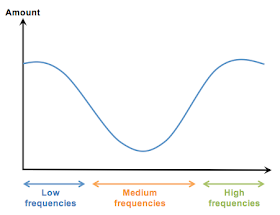
Here is the schematic of the tonestack (I used the Big Muff Page's annotations for the parts names):
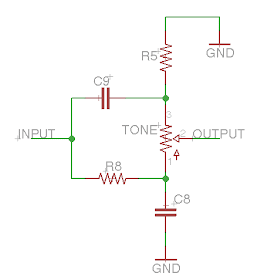
It is composed of two passive RC filters, a high pass and a low pass filter. The tone potentiometer mixes the two filters to let more or less bass / treble going through.
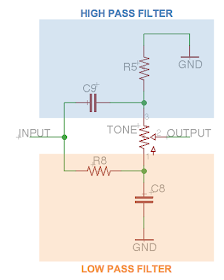
High pass filters let frequencies pass when they are above a fixed cutoff frequency, and low pass filters let frequencies below a fixed cutoff frequency pass (tip to remember: "low pass = below"). Here are examples for both low pass and high pass filters:
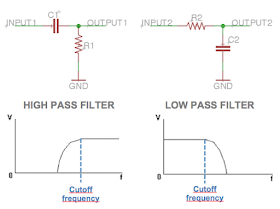
So basically, high pass lets trebles go through, and low pass let the bass frequencies go through. As you can see, the sound is not "cut" directly, but is reduced progressively. So when you turng the "tone" knobNow, why are the mids taken out when passing through this tone stack? To know that, we can calculate the cutoff frequency of these 2 filters. The formula to calculate it is:

Beware: R is in Ohms, and C in Farads. Lets take the Violet Era Ram's Head Big Muff as an example. The values are:
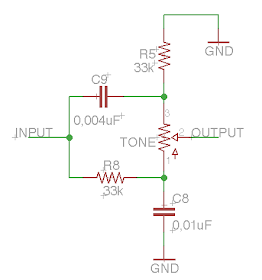
We can calculate the cutoff frequencies of the high-pass (HP) and low-pass filters (LP):

Boom! Here is the mid scoop that we hate when playing in a band! How to change it? As we have previously seen, the value of the cutoff frequency depends on the value of the components (R and C). So changing these components will change the mids scoop! Actually, as the Big Muff circuit changed a lot during its history, the mid cuts is more or less pronounced depending on the era of the model. Green russian Big Muff for instance have a less pronounced mids cut. Here are the tonestacks of all versions:
- Triangle Big Muff: R5: 22k , R8: 22k , C8: 0.01uF, C9: 0.004uF (723 / 1809 Hz)
- Ram's Head Big Muff (73 version): R5: 33k , R8: 33k , C8: 0.01uF, C9: 0.004uF (482 / 1206 Hz)
- Ram's Head Big Muff (75 version): R5: 22k , R8: 39k , C8: 0.01uF, C9: 0.004uF (408 / 1809 Hz- big scoop of the mids)
- Big Muff "Civil War": R5: 22k, R8: 20k, C8: 0.01uF, C9: 0.0039uF (796 / 1855 Hz)
- Big Muff Russian "Tall Fonts": R5: 22k, R8: 20k, C8: 0.01uF, C9: 0.0039uF (796 / 1855 Hz)
- Big Muff Russian "Buble Fonts": R5: 22k, R8: 20k, C8: 0.01uF, C9: 0.0039uF (796 / 1855 Hz)
- Flat mids: R5: 22k, R8: 39k, C8: 0.01uF, C9: 0.01uF (408 / 723 Hz)
- Mids bump: R5: 22k, R8: 39k, C8: 0.0056uF, C9: 0.01uF (729 / 723 Hz)
AMZ fx had the really great idea of using a resistor plus a potentiometer for R5. Thus, you can modulate the cutoff frequency of the high pass filter. If you diminish the value of the resistor, the cutoff frequency will be lower, and thus you will get more mids.
You can modulate the values of C8, R8, C9 or R5-1 depending the kind of sound you want. Generally, a small value is used for R5-1 (like 2.2k), and the Mids knob is a 25k linear potentiometer. This is what I used for the Big Muff "Black Keys" build! A lot of manufacturers and builders use this technique to add a "mid" knob to their Big Muff. Here are a few examples:
- Earthquaker Devices Hoof fuzz: R8: 39k, C8: 0.0068uF, C9: 0.0068uF, R5-1: 2.2k
- AMZ fx v1: R8: 39k, C8: 0.01uF, C9: 0.012uF, R5-1: 3.3k
- AMZ fx v2: R8: 470k, C8:1500pF, C9: 0.015uF, R5-1: 3.3k, tone: 250kA (the one I use here)
- Earthbound Audio Supercolider: R8: 39k, C8: 0.01uF, C9: 0.01uF, R5-1: 10k

- Blackout Effectors Musket Fuzz: R8: 10k, C8: 0.047uF, C9: 0.0033uF, C9bis: 0.047uF R5-1: 56k
- Mojo Hand FX Colossus: R8: 10k, C8: 0.047uF, C9: 0.022uF, C9bis: 0.056uF R5-1: 47k
- Mojo Hand FX Iron Bell: R8: 18k, C8: 0.01uF, C9: 0.0068uF, C9bis: 0.033uF R5-1: 33k
Have fun experimenting!
To go further:
AMZ Big muff tonestack: great explanations and tweakings around the Big Muff tonestack
AMZ RC filters cutoff calculator: great if you do not want to use your calculator for cutoff frequencies calculations
Big Muff mods and tweaks: tonestack mods
Frequency response of different models of Big Muff
Modding the Big Muff tonestack (guitarkitbuilder)


hi benoit,
ReplyDeletenice resource you have created with your site!
i am really digging it.
i always add a mid control to my muffs, but i use a 2.7k resistor in line with
a 100k pot.. i can cut the mids or boost them substantially that way.
also found another mod that i use in my builds...
on the big muff board from EH itself, the numbers are wrong compared to the schematics... if ya look for what's marked d4 on the circuit board, and parallel the existing si diode with an 1n34 ge diode, it works as a noise gate and wipes out most of the "ocean" in the background without taking away your balls or messing with your tone.
i don't know why it works, but it does.
check it out sometime if ya get the chance and let me know
if it works for you, too
peace!
jimi
How would I go about removing the tone stack from a REV E NYC Muff? looking at a schematic, would I simple have to run a jumper from C10 to C13? Any advice is appreciated.
ReplyDeleteremove the tone pot, r5, r8, c8 and c9. then tie the the center pad of where the pot goes to the bottom solder pad for r8. worked for me at least haha.
ReplyDeleteThanks a lot! When you removed R5, R8, C8 and C9 did you jump them, or literally just leave them empty?
ReplyDeleteHow could I add a mini toggle switch to make mids flat and also stock?
ReplyDeleteThis comment has been removed by the author.
ReplyDeletejust open the way just before c9 and r8, take the input of the tonestack to a common pin on a spdt switch, then one side of the switch take it to the joint of c9 and r8 and the other side of the switch to the centre of the output pot of the tone stack
ReplyDeleteThis also depends on the amp you are using. The Fender Hot Rod Deluxe is a very Midy amplifier. Some pedals do not play well with it, and that is usually pedals with a lot of mids. Something to think about.
ReplyDelete